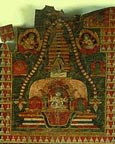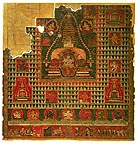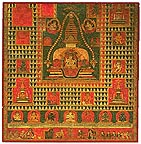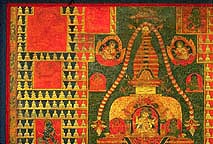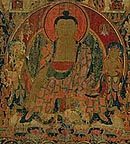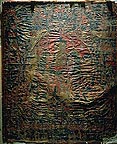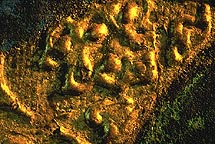The History of the Art History of Tibetan Art
| Top |
Scholarship on the art history of Tibet, indeed on that of the Himalayas, began in earnest only in the 1960s. At this time some of the first really significant exhibitions of such material occurred. This attention to Himalayan art helped start new collectors; for instance, one of the major private collections, that of the Zimmerman family, began after their visit to the 1964 show "Art of Nepal" curated by Stella Kramrisch at the Asia Society in New York City. In his review of the 1969 exhibition "Art of Tibet," curated by Pratapaditya Pal (now senior curator at LACMA), John Rosenfield of Harvard University wrote that the show had been a somewhat unnerving success. He noted that shows at the Asia Society were always generally well attended due to the number of people living there interested in Asia, but the attendance for this exhibition was vastly swelled "by the rebellious young who are attached to the occult imagery, to the swirling color effects so akin to the psychedelia, to the sense of the horrendous and grotesque and to the overt sexuality of some of the divine images."(1) Clearly, the Western world did not quite know what to make of this art. Unfortunately, two decades later, the awareness among the general public of this material as works of major artistic achievement is still limited. This is so even as the Dalai Lama and the plight of the Tibetan people under Chinese rule has led to a greater awareness and at least vague sympathy for the religious beliefs from which such works spring. Today, Himalayan art is still not regularly included in survey texts of world art and has not yet achieved a stable presence in Western museum displays. Exceptions in the United States include long-established collections like those in the Boston Museum of Fine Arts and the Newark Museum, and more newly formed collections at the Cleveland Museum and LACMA.
LACMA's unique position as holding a great collection of Himalayan art is largely the result of two factors: the purchase of the Heeramaneck collection in 1969, acclaimed by "Time" magazine as the single most important art purchase since World War II, and the involvement since then of Pratapaditya Pal, one of the leading scholars in the field, who has with the aid of various private donors amplified LACMA's collection so that it is one of the most comprehensive, with many examples of unsurpassed quality. One of the strengths of Nasli and Alice Heeramaneck's collection was Himalayan art, and among many splendid works are Tibetan paintings that had once belonged to Giuseppe Tucci, who was one of the few to enter Tibet in the middle of the twentieth century and who collected important works of art at various sites in Tibet. Tucci was probably the most important scholar in this century on Tibet. Tucci put a group of his paintings up for sale in a show in New York in the 1950s; none sold until Heeramaneck, with his customary foresight, bought the lot.
Clearly there is still much to be done to heighten the awareness of Himalayan artistic achievements, but it is an area that continues to grow in popularity and serious acceptance, as witnessed by the major recent acquisitions of such works by the Virginia Museum of Art (which also had received an earlier gift from Paul Mellon in 1968 of some paintings collected by Tucci which had been owned by Heeramaneck).
A major focus of studying this material continues to be in terms of ethnography or religions; there are many more books on Tibetan iconography than on Tibetan painting styles. Even the widely acclaimed recent show of Tibetan art, "Wisdom and Compassion," maintained this emphasis. The problem is that both orientations are needed. Buddhism is the predominant religion in Tibet and hence most religious paintings depict Buddhist subjects; they are devotional and often are the focus of worship in a home or temple. The primary function of an image, whether sculpture or painting, is for visualization; an aid to meditation and initiation practices. The image is simply the symbolic form given to a spiritual content that draws life and meaning from the teaching it imparts. Enlightened understanding recognizes that there is no duality; hence, images of sexual embrace speak eloquently, in the most human of terms, about the unity of seeming opposites, reality as non-duality.
 |
| Fig. 1 A 19th-century Tibetan Thangka |
A Tibetan painting is called a thangka, meaning rolled-up image. Thangkas are painted in opaque watercolor on cotton fabric and often are mounted in elaborate brocades. They are more than simply two-dimensional images, literally and symbolically. Although practices have changed over time, they were always meant to be mounted and seen as 3-dimensional constructs, a concept which is unfortunately hampered by Western presentations that cut away the mounts to mat and frame the paintings. Thangkas were meant to breathe as a hanging does, and they also were meant to be seen as 3-dimensional projections of a world which was to become the devotees. Most thangkas are unsigned and undated and thus difficult to place in a precise context. These religious paintings were commissioned for both spiritual and mundane matters--perhaps dedicated to a sick person, or to remove spiritual or physical obstacles to a particular end, or to help a deceased person receive a happier rebirth. They were also commissioned for special religious occasions to help the donor to gain merit (the artist also benefited); unfortunately, it is seldom that this information is preserved in an inscription.
Tibetan thangkas exhibit a variety of styles and an almost bewildering array of deities reflecting developments of the Vajrayana form of Buddhism, which, although it originated in India, developed in Tibet in distinct ways. The understanding of the development of iconography and styles is far from complete. Tibet was virtually inaccessible to Westerners in the 20th century until the early 1980s, and doubtless the material now emerging will change some of the established ideas about the development of Tibetan art. The history of Tibetan painting is inextricably tied up with the history of religious developments because the works were made to be functional. Much is still to be determined about both, and ultimately the paintings must be examined in light of other types of works, sculptures, manuscripts, etc., both in terms of their styles and uses as well as with a consideration of their original context. Curators, scholars, and collectors must still grapple with issues about how to present these works in a contextual manner so that insights gained from considering the history of the lives of these works, which does remain with them, are preserved. Thus consideration of their condition, their mounts, and their renovations are proving invaluable in the search to understand such works more fully. Indeed, it will be the collaboration among those with different interests and abilities--including conservators--that will permit the most successful retelling of those worlds so beautifully--if incompletely--presented to us by these surviving images.
Footnote
1. Rosenfield, John: "Tibetan
Art at Asia House," Oriental Art, Volume 15, No. 3,
1969, page 223.
Click here to return to text.
author address:
Janice Leoshko, Associate CuratorIndian and Southeast Asian Art
Los Angeles County Museum of Art
5905 Wilshire Blvd.
Los Angeles, California 90036
